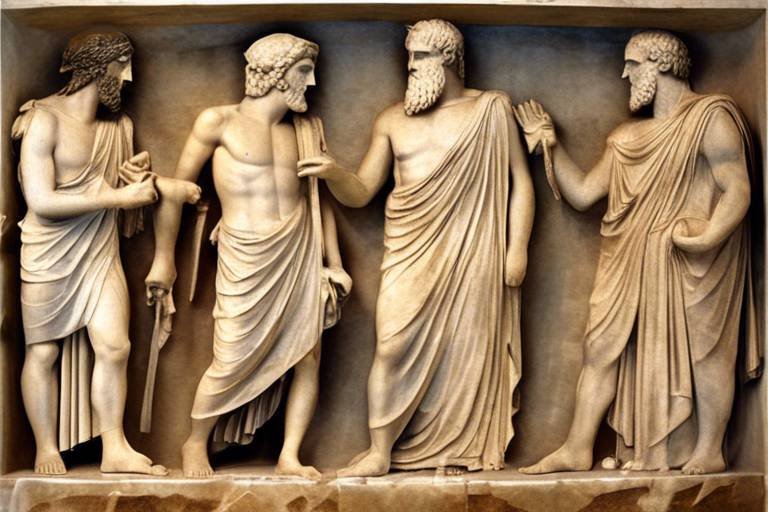The Discovery of the Ancient Assyrian Empire's Art
Exploring the ancient ruins of the Assyrian Empire is akin to embarking on a thrilling journey through time, where each artifact and artwork unveils a chapter of a once-mighty civilization. The significance of uncovering the art of the Ancient Assyrian Empire lies in the profound insights it offers into the rich history, culture, and artistic achievements of this ancient civilization.

History of the Assyrian Empire
The history of the Assyrian Empire is a tale of power, conquest, and cultural achievement that has left a lasting impact on the ancient world. Originating in the region of Mesopotamia, the Assyrians rose to prominence as a formidable military force, expanding their empire through strategic warfare and diplomatic alliances. Known for their ruthless tactics on the battlefield, the Assyrians established one of the largest empires of the ancient world, encompassing vast territories and diverse populations.
At its peak, the Assyrian Empire reached its zenith under rulers such as Tiglath-Pileser III, Sargon II, and Ashurbanipal, who implemented innovative military strategies and administrative systems to govern their vast domain. The Assyrians were not only skilled warriors but also patrons of art and architecture, commissioning grand palaces, temples, and monuments that showcased their cultural sophistication.
However, the glory of the Assyrian Empire was not destined to last forever. Internal strife, external invasions, and rebellions from subject peoples eventually led to the gradual decline of the empire. The city of Nineveh, once a thriving metropolis and capital of the Assyrian Empire, fell to the Babylonians and Medes in 612 BC, marking the end of Assyrian dominance in the region.
Despite its eventual downfall, the legacy of the Assyrian Empire lives on through its art, literature, and innovations in governance and warfare. The rediscovery of Assyrian artifacts and archaeological sites has provided valuable insights into this ancient civilization, allowing us to appreciate the richness and complexity of Assyrian culture.

Assyrian Artifacts and Architecture
Uncovering the art of the Ancient Assyrian Empire is a momentous discovery that provides a window into the rich cultural heritage and artistic achievements of this ancient civilization.
The artifacts and architecture of the Ancient Assyrian Empire stand as a testament to the remarkable artistic skills and cultural sophistication of the Assyrian people. Through intricate sculptures, detailed reliefs, and awe-inspiring architectural marvels, the Ancient Assyrians showcased their creativity and mastery in various art forms.
One of the most notable architectural wonders of the Assyrian Empire is the Palace of King Sennacherib. This grand structure not only served as a royal residence but also housed exquisite artwork and intricate designs that offer insights into the opulent lifestyle of Assyrian royalty.
Another significant aspect of Assyrian art is the use of cylinder seals. These small, cylindrical objects were intricately carved with designs and inscriptions, serving both practical and symbolic purposes in Assyrian culture. The detailed craftsmanship of these seals provides a glimpse into the artistic sophistication of the Assyrians.
The excavations and archaeological finds related to the Ancient Assyrian Empire have unearthed a treasure trove of artifacts that offer valuable insights into the civilization's history and culture. Sites like Nimrud have yielded a wealth of artifacts, inscriptions, and architectural remains that shed light on the daily life and beliefs of the Assyrian people.
The influence of Assyrian art extends far beyond the borders of the ancient empire, shaping the artistic traditions of future civilizations and leaving a lasting impact on art and culture. The intricate designs, symbolic motifs, and artistic techniques of the Assyrians continue to inspire artists and scholars to this day, highlighting the enduring legacy of Assyrian art.

Palace of King Sennacherib
Uncovering the art of the Ancient Assyrian Empire is a significant archaeological breakthrough that offers a glimpse into the rich cultural heritage and artistic achievements of this ancient civilization.
The Assyrian Empire, renowned for its military might and cultural advancements, rose to power in the ancient Near East and dominated the region for centuries. Known for their strategic warfare tactics and organizational skills, the Assyrians established a vast empire that stretched across Mesopotamia.
The artistic prowess of the Ancient Assyrians is evident in the intricate sculptures, detailed reliefs, and impressive architectural structures that have been unearthed by archaeologists. These artifacts showcase the skill and creativity of the Assyrian artisans, providing valuable insights into their society and beliefs.
The Palace of King Sennacherib stands as a testament to the grandeur and sophistication of Assyrian art and architecture. Adorned with elaborate carvings and intricate decorations, the palace offers a glimpse into the opulent lifestyle of the Assyrian royalty. The walls depict scenes of battle victories, religious ceremonies, and daily life, providing a vivid portrayal of Assyrian culture.
Cylinder seals played a crucial role in Assyrian art and culture, serving as both practical tools and artistic expressions. These intricately carved seals were used to mark documents and goods, showcasing detailed designs and historical narratives that offer valuable insights into Assyrian society and beliefs.
Archaeological excavations have unearthed a treasure trove of Assyrian artifacts, including sculptures, pottery, and inscriptions that shed light on various aspects of Assyrian life. The discoveries made at sites like Nimrud and Nineveh have provided archaeologists with valuable information about the daily lives, religious practices, and artistic achievements of the Ancient Assyrians.
The excavations at Nimrud have revealed a wealth of artifacts, including intricately carved ivories, ornate jewelry, and well-preserved architectural remains. Inscriptions found at the site have provided valuable historical information, giving researchers a deeper understanding of the political and cultural landscape of the Assyrian Empire.
The influence of Assyrian art extends far beyond the borders of the ancient empire, shaping the artistic traditions of subsequent civilizations and leaving a lasting impact on art and culture. The intricate designs, symbolic motifs, and storytelling techniques of Assyrian art continue to inspire artists and historians to this day, highlighting the enduring legacy of this ancient civilization.

Assyrian Cylinder Seals
The hold a unique place in the artistic and cultural heritage of the Ancient Assyrian Empire. These cylindrical artifacts, typically made of stone or clay, were intricately carved with detailed designs and inscriptions. The seals were used by the Assyrians as a form of identification and authentication, much like a modern-day signature or stamp. When rolled onto clay tablets or documents, the cylinder seals left behind a distinct impression, marking the document as genuine and official.
One of the most fascinating aspects of Assyrian cylinder seals is the intricate designs engraved on them. These designs often depicted scenes from daily life, religious rituals, and mythological stories. The craftsmanship and attention to detail in creating these seals were truly remarkable, showcasing the artistic skill and creativity of the Ancient Assyrians.
Moreover, the cylinder seals also served a symbolic and protective function in Assyrian culture. Some seals were believed to possess magical properties, offering protection against evil forces or bringing good luck to the bearer. The intricate patterns and symbols carved on the seals held deep significance, reflecting the beliefs and values of the Assyrian society.
Archaeological excavations have unearthed a vast number of Assyrian cylinder seals, providing valuable insights into the daily life, religious practices, and social structure of the Ancient Assyrians. These seals not only served practical purposes but also served as a form of artistic expression and storytelling, preserving the rich cultural heritage of the Assyrian Empire for future generations to admire and study.

Excavations and Archaeological Finds
Excavations and archaeological finds have been instrumental in unraveling the mysteries of the Ancient Assyrian Empire. Through meticulous digging and analysis, archaeologists have unearthed a treasure trove of artifacts that provide valuable insights into the civilization that once thrived in Mesopotamia. These excavations not only shed light on the daily lives of the Assyrians but also highlight their artistic and technological achievements.
One of the most renowned excavations related to the Ancient Assyrian Empire is the discovery of the city of Nineveh. This ancient city, once a thriving metropolis, revealed a wealth of artifacts, including clay tablets with cuneiform inscriptions, sculptures, and architectural remnants. These findings have helped historians piece together the political and social structures of the Assyrian society, offering a glimpse into their governance and religious practices.
Furthermore, excavations at the site of Ashur, the ancient capital of the Assyrian Empire, have unearthed temples, palaces, and tombs that provide valuable clues about the religious beliefs and burial practices of the Assyrians. The intricate carvings and decorations found in these structures showcase the artistic sophistication of the Assyrians, highlighting their mastery in craftsmanship and design.
Archaeologists have also uncovered a significant number of Assyrian artifacts in the ruins of Nimrud. These findings include intricately carved ivory panels, jewelry, and pottery, all of which speak to the rich cultural heritage of the Assyrian Empire. The meticulous attention to detail in these artifacts reflects the importance of art and aesthetics in Assyrian society, emphasizing their penchant for beauty and symbolism.
Moreover, the excavation of ancient Assyrian tombs has provided valuable insights into funerary practices and beliefs surrounding the afterlife. The discovery of burial chambers with elaborate grave goods and inscriptions has deepened our understanding of how the Assyrians commemorated and honored their deceased, shedding light on their spiritual beliefs and rituals.
Overall, excavations and archaeological finds related to the Ancient Assyrian Empire continue to captivate researchers and enthusiasts alike, offering a glimpse into a civilization that flourished thousands of years ago. These discoveries not only enrich our knowledge of history but also underscore the enduring legacy of the Assyrians in shaping the cultural landscape of the ancient world.

Nimrud Excavations
The Nimrud Excavations have unveiled a treasure trove of ancient wonders, offering a glimpse into the rich history and artistic achievements of the Assyrian Empire. Situated near the Tigris River in modern-day Iraq, Nimrud was once a thriving city at the heart of the Assyrian civilization. Archaeological digs at Nimrud have unearthed a plethora of artifacts, inscriptions, and architectural remains that provide valuable insights into the daily life, beliefs, and customs of the Assyrians.
One of the most remarkable discoveries at Nimrud is the Palace of Ashurnasirpal II, a magnificent structure adorned with intricate carvings and reliefs depicting scenes of royal ceremonies, battles, and mythical creatures. These artistic masterpieces not only showcase the technical skill of Assyrian craftsmen but also offer a window into the cultural and religious practices of the time.
Among the notable finds at Nimrud are the famous Nimrud Ivories, a collection of intricately carved ivory objects that highlight the Assyrians' expertise in craftsmanship and artistic expression. These delicate artifacts, including furniture inlays, plaques, and figures, demonstrate the sophistication and creativity of Assyrian artisans.
Furthermore, the discovery of the Black Obelisk of Shalmaneser III at Nimrud has provided valuable historical and cultural information. The obelisk, carved with detailed scenes of tribute-bearing peoples, offers insights into the military conquests and diplomatic relations of the Assyrian Empire during the reign of Shalmaneser III.
The Nimrud Excavations continue to yield new discoveries and shed light on the enduring legacy of the Assyrian Empire. Through the meticulous work of archaeologists and researchers, the ancient city of Nimrud is gradually revealing its secrets, enriching our understanding of this influential civilization and its contributions to art, architecture, and history.

Legacy of Assyrian Art
Exploring the Legacy of Assyrian Art reveals a captivating journey through time, uncovering the profound impact of the Ancient Assyrian Empire on the world of art and culture. The legacy left behind by the Assyrians transcends generations, influencing artistic expressions and architectural designs across various civilizations.
The artistic achievements of the Ancient Assyrians have left an indelible mark on the history of art. Through their intricate sculptures, detailed reliefs, and innovative architectural designs, the Assyrians showcased a level of craftsmanship and artistic vision that continues to inspire artists and art enthusiasts to this day.
One of the most remarkable aspects of Assyrian art is its ability to convey powerful narratives and historical events through visual representations. The intricate details found in Assyrian artifacts not only serve as aesthetic marvels but also as historical archives, providing insights into the beliefs, customs, and daily life of the Assyrian people.
The legacy of Assyrian art extends beyond its artistic achievements to its influence on subsequent civilizations. The artistic motifs and techniques developed by the Assyrians have been adopted and adapted by various cultures, shaping the artistic landscape of the ancient world and beyond. From the majestic palaces adorned with intricate reliefs to the symbolic significance of cylinder seals, Assyrian art has left an enduring legacy that continues to resonate in the art world.
Moreover, the discovery and preservation of Assyrian artifacts have not only enriched our understanding of ancient civilizations but have also sparked a renewed interest in Assyrian art and culture. Museums and art institutions around the world showcase Assyrian artifacts, allowing visitors to appreciate the artistic mastery and historical significance of these ancient treasures.
In conclusion, the Legacy of Assyrian Art stands as a testament to the artistic ingenuity and cultural richness of the Ancient Assyrian Empire. By delving into the artistic achievements and architectural marvels of the Assyrians, we gain a deeper appreciation for the enduring impact of their art on the world of art and culture.
Frequently Asked Questions
- What is the significance of Assyrian art?
Assyrian art holds immense historical and cultural significance as it provides a window into the rich and powerful civilization of the Ancient Assyrian Empire. The art reflects the military prowess, architectural achievements, and cultural sophistication of the Assyrians, offering valuable insights into their way of life and beliefs.
- What are some notable examples of Assyrian artifacts?
Notable examples of Assyrian artifacts include intricately carved sculptures, detailed reliefs depicting historical events and deities, and impressive architectural structures such as the Palace of King Sennacherib. The Assyrian artifacts showcase the artistic skill and cultural depth of the civilization.
- How did the discovery of Assyrian art influence subsequent civilizations?
The discovery of Assyrian art has had a profound influence on subsequent civilizations, inspiring artists, architects, and historians around the world. The detailed craftsmanship, storytelling through art, and grandeur of Assyrian pieces have left a lasting impact on art and culture, shaping artistic practices for generations to come.



















